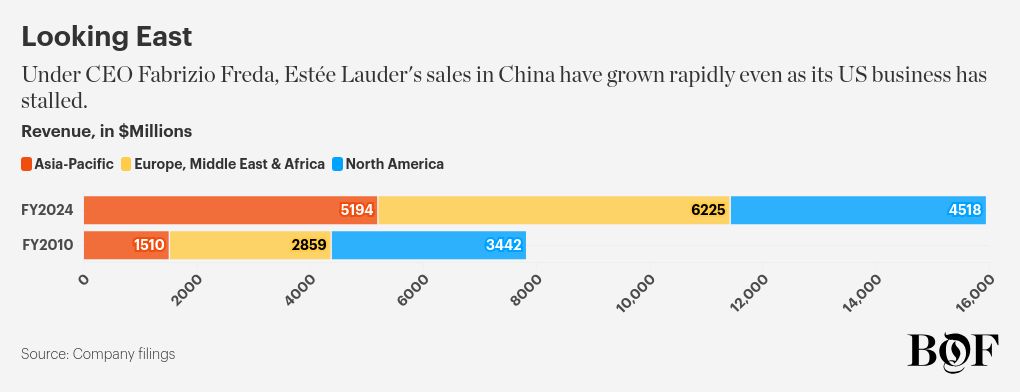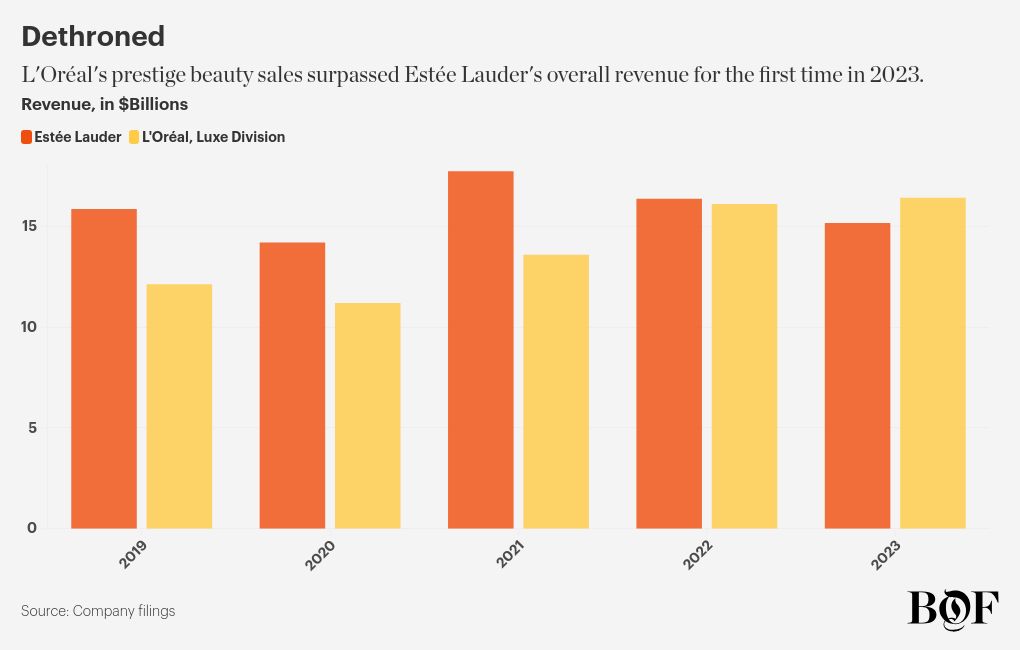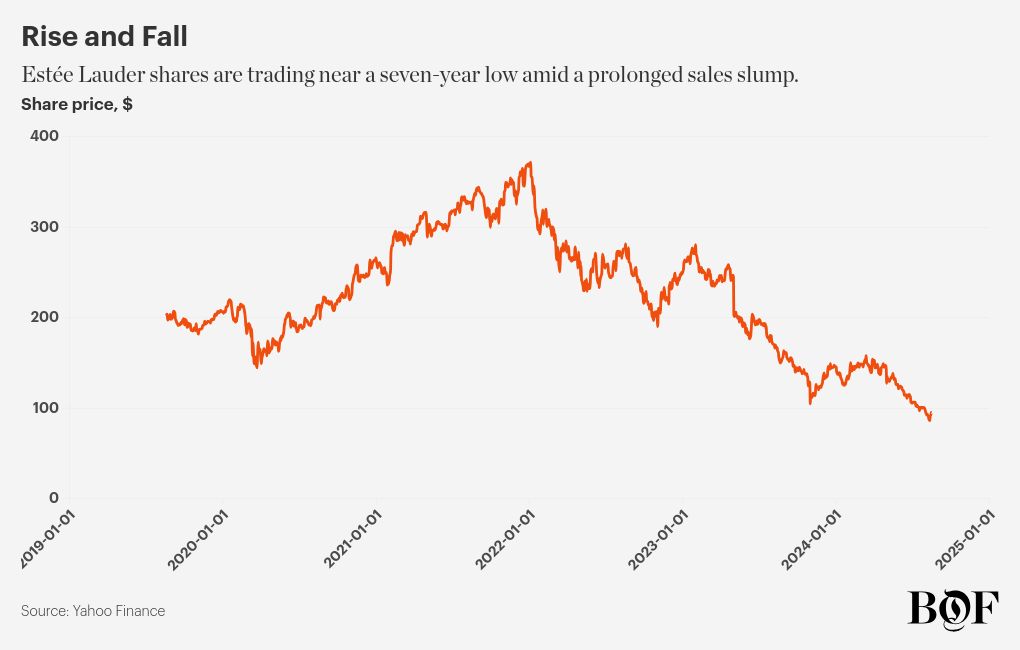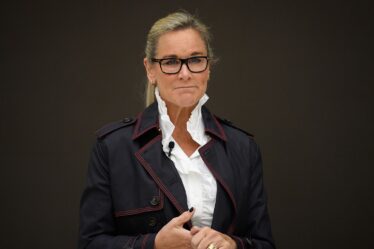
Mere hours after longtime Estée Lauder Companies chief executive Fabrizio Freda announced his retirement, the beauty giant’s leaders had a message for his yet-to-be-named successor: You’ve got your work cut out for you.
The beauty giant on Monday reported a second consecutive year of declining sales, with prestige beauty and China — two key growth drivers for much of Freda’s 15-year tenure — dragging on results. In Hainan, a vacation shopping hub, sales declined by 40 percent in the most recent quarter compared with a year ago. The company said to expect more of the same in the coming year, projecting revenue would come in anywhere from down 1 percent to up 2 percent in fiscal 2025.
“We are certainly not pleased with our overall full year result,” said chief financial officer Tracey Travis, who is also set to retire in November. (Freda’s tenure is set to end in June 2025.)
Estée Lauder’s sputtering trajectory following the pandemic is well-documented. The company has been hamstrung by the slow recovery of the Chinese economy and its late adoption of platforms like TikTok, as well as a sluggishness in creating and capitalising on trends, denting the cool factor for some of its brands. Its stock is down 75 percent from its December 2021 peak and is trading near a seven-year low.
What was new on Monday was a willingness by Freda and other top executives to publicly address the wider scope of the problems facing the company, analysts say.
“For the first time, they’re acknowledging a much worse environment,” said Filippo Falorni, a director in Citi’s consumer practice.
While Freda told analysts on Monday he’d spend his final year in the CEO role ensuring “our next leader inherits a business with momentum,” investors are keen for a fresh start, with Falorni saying they favour an external hire, citing the share jump Starbucks saw after poaching Chipotle’s CEO earlier this month. The next CEO needs to bring big ideas, restart the innovation machine for some of its flagship ailing brands, galvanise staff and do it all on a tight budget.
“[Investors] want a fresh set of ideas coming from a different company, ideally L’Oréal or one of their competitors,” said Falorni.
Changing Fortunes
Freda, who joined Estée Lauder in 2008 and assumed the CEO role in the summer of 2009, presided over the company’s fat years, when it made a series of big-ticket acquisitions, snapping up the likes of The Ordinary, Too Faced and Tom Ford. During his first decade in the top job, Freda also bolstered Estée Lauder’s business outside the US, overseeing an aggressive expansion into China, including a bet on a practice known as daigou, where Chinese shoppers get a surrogate to purchase on their behalf from overseas at a lower price. China now makes up about one-third of global sales, from under 20 percent when Freda joined the company.
Before the pandemic, these moves helped Estée Lauder build a comfortable lead as the world’s biggest purveyor of prestige beauty products.
Then came the lean years. Estée Lauder’s strength in China has become a serious vulnerability as Chinese consumers have increasingly turned their backs on premium Western brands and the economy has stagnated.
Meanwhile, trouble was brewing at home; a wave of new brands, from buzzy cosmetics lines like Saie and Kosas to viral skincare brands like Cerave and Rhode captured the attention of consumers.
Estée Lauder’s competitors were quick to adapt, taking stakes in fast-growing celebrity lines, adding more fashion house licences, investing in emerging platforms like TikTok and building relationships with dermatologists to promote their products. ELC was more reliant on travel retail and department stores, and had withdrawn some of its brands from showing at key dermatology trade shows, while once-buzzy brands were stuck with dated marketing.
Korinne Wolfmeyer, a senior analyst at investment bank Piper Sandler, said that brand reinvigoration work had begun under the current leadership and was on the right track. In March, Clinique returned to the American Academy of Dermatology trade show to network with dermatologists and present research — in 1973, it was the first beauty brand to be invited — while Jo Malone London signed the actor Tom Hardy as its first-ever celebrity face in May.
“But with investors, it’s kind of a ‘show me’ story,” she said, referring to the low stock price.
The news wasn’t all bad on Monday: Sales rose 8 percent in the fourth quarter, and skincare is proving an unexpected bright spot, with sales up 15 percent in the period. Operating margins have also improved. But it hasn’t been enough to keep pace with competitors. Last year, L’Oréal surpassed it as the largest prestige beauty company by sales.
The Road Ahead
While the company said it was “well advanced” in its succession planning, and considering internal and external candidates, Freda’s successor has not yet been named.
On Monday’s call, Freda laid out a few potential levers for growth. New customer acquisition is a top priority, said Freda, adding that the company has 200 million consumer profiles it can exploit, with a focus on precision marketing, while internal processes will be shaken up to allow local teams to respond to trends faster.
Wolfmeyer said any progress, be that in innovation or in new channels, needs to be paced accordingly, saying she had been surprised by how quick the company had been to launch its brands on Amazon.
“They need to get into the right retail partners, but not move too quickly, so they can protect their margins,” she said.
Some savings from its ongoing profit and growth recovery plan will be reinvested for more investments in advertising and new product development, especially in dermatologist-led skincare and fine fragrance. The launch of a Balmain beauty brand, slated for September, will further grow its luxury presence.
The myriad issues that need to be addressed, including building youth appeal, beating downward trends in soft markets, achieving more viral success and creating excitement around its brands have to be done on a very tight budget.
Falorni noted that even when things were going well at Lauder, its cost structure was inefficient, with its margins 3 to 4 percent lower than L’Oréal luxury division.
“Delivering on all those priorities and also on profit recovery is not easy,” he said, adding that new executives usually prefer to set their own goals, which won’t be possible in the middle of its ongoing profit recovery plan.
Freda said on the earnings call that he is cognisant that the next CEO needs to be more than just a steward.
“I think the successor has to be a great leader and understand the key elements of our company …one of the key elements is being a brand builder who can develop growth,” he said.
Sign up to The Business of Beauty newsletter, your complimentary, must-read source for the day’s most important beauty and wellness news and analysis.




